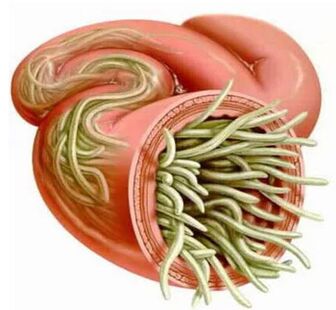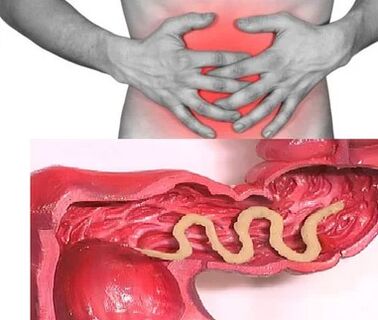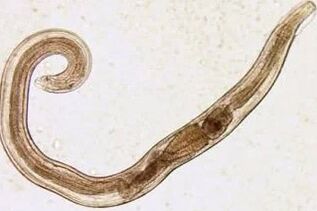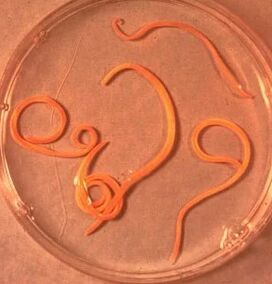To date, science is known for 280 types of worms that can grow and live in the human body, parasitized in various organs and tissues.The frequency of human infection depends on the climatic and socio -economic conditions of specific territories (in underdeveloped countries, especially in those in the tropical and subtropical zone, the level of parasitic infections is much higher than in economically developed states).
Methods of human infection with helminth:
- Bioayagmy (infection by animals).
- Helminthoses Contagioine (transmitted from person to person).
- Geogelmintoses (diseases caused by parasites conducting one of the vital circles on Earth).

Factors affecting helminth events
The method of penetrating the parasite into the body:
- The degree of adaptation of helminth to the human body.
- The density of the population (quantity) of parasitic people;
- The worm habitat (tissue parasites live in the thickness of the soft tissue and the clearance lives in the gaps of the hollow organs).Some helm in various phases have forms of educational and fabrics.The larvae and the growing stages of the worms, as a rule, cause more intense pathological changes.
In the absence of repetition, the number of adult pests in the human body does not increase.This characteristic significantly distinguishes the helminth invasions of diseases caused by bacteria, viruses, fungi and simple organisms.
Worms to people: symptoms
Helminth is a disease characterized by 2 stages of the lesson (acute, from two weeks to two months) and years (from several months to several years).
Symptoms of Octy Phase of Helminth
The first signs of the disease can occur at different times (more often after 2-3 weeks, with ascar installation-after 2-3 days, and with leafing, the incubation period may take 6-18 months).
In the acute stage of the parasitic invasion, the most characteristic symptom is an allergic reaction (antibodies are produced in migratory antigens of pests).Often, itchy rashes, prone to recurrent course, have an increase in the recurrent course, peripheral lymph nodes appear on the skin and the appearance of generalized or local edema, muscle and articular pain may occur.Also, migratory larvae of the parasite can cause chest pain, cough, suffocation, stool disorders, nausea and vomiting.
At the same time, the acute phase of helminth may be accompanied by more severe disorders (severe forms of pneumonia, hepatitis, allergic myocarditis, hepatostetrogal (increase in liver and spleen).
In blood, the amount of eosinophils (eosinophilia) increases and the normal quantitative ratio between protein fractions (dyspothemia) is disturbed.

Signs of chronic helminth
The symptoms of the chronic phase depend directly on which organ is "completed" with parasites, as well as their size and quantity play an important role.
Thus, when parasitic in the intestines of individual individuals, the disease can occur asymptomatic (with the exception of cases of infection with very large parasites).The characteristics of the chronic phase of the intestinal helminth are dyspentine disorders.In children, ACENOAROTIC and PAIN Syndrome are more intense.With a huge Ascarides invasion, the intestinal obstruction, the jaundice and pancreatitis engineer.
By consuming all the substances required for their vital activity by the host body, helminths cause digestive disorders, violations of absorption of vitamins, minerals, carbohydrates, proteins and fat.At the same time, the products of worms' life inhibit normal intestinal microflora and reduce the body's immune forces.
In people with helminths, due to impaired immunity and the enhanced cell division process (consequences of continuous tissue pests), the risk of malignant tumors increases significantly.
Types of Parasites in the Human Body
The causative agents of human helminth are 2 types of worms: round (nematody) and flat (ribbon and saucers).
Round worms
Pinworm
The parasites that are the cause of the enterobilization are small (up to 10 mm) thinner cavity worms that have grayish-white staining.The infection occurs in a dietary manner (through the mouth).The reason for this is the dirty hands.Parasite eggs can be found on the ground, in the wool of infected animals, in unwashed vegetables and fruits, etc.At the same time, with entering, cases of self -extension (especially in children) that occur as a result of the hairstyle areas and the subsequent eggs of the eggs are not uncommon.The cutting larva develops within two weeks on the digestive tract.By turning into an adult person, the worm gives up the lower parts of the small and upper parts of the colon.

Askarida
Askaride is a large parasite of a form of spindle-shaped red yellow color, reaching a 40 cm adult (female) and 15-25 cm (male) state.Without a suction cup or other fastening devices, Ascaride can be moved independently to the masses of food.Eggs determined by the female parasite are distinguished by stool.
ACADOSIS contamination occurs in the event of swallowing ripe eggs along with water or unwashed vegetables and fruits in which there are soil particles.After the eggs penetrate the intestines, the ripened larvae come out of them.Then, by inserting the intestinal wall, they reach the heart according to the blood flow and from there fall into the lungs.Through the pulmonary cells, the larva of Askaritis through the respiratory tract penetrates the oral cavity again.After repeated ingestion, the parasite reaches the small intestine, where it grows in an adult.The worm lives for 12 months, then dies and stands out with stools.One or several hundred people can live in the intestines of a owner.
Vlasev
Vlasov, the causative agent of the hair head, is a white helminth that is paralyzed in the original part of the colon and reaches a size of 4-5 cm.The parasite is powered by the blood and tissues of the rectum mucosa.
Eggs with obliquely -determined female on the walls of the intestine come out with the feces.Their growth occurs in the environment (optimally on the ground).Eggs with pest larvae penetrate the body in a nutritional way, through dirty hands, with water or unwashed vegetables and fruits.

Hair
The causative factor of tricholos is a small round elmid that reaches a length of 2-5 mm.Infection occurs when the use of poorly fried meat (pork, teddy bears, wild boar).The penetration in the intestines, the pest's larva in 3-4 days matures in the state of the sexually mature person.The life expectancy of the worm is 40 days, after which the parasite dies.Driving the intestinal wall, the larvae penetrate the bloodstream and are transferred to all organs of the human body, installing the muscles.In this case, respiratory and facial muscles are most often affected, as well as the end muscles of the extremities.
In the first days after invasion, patients complain about abdominal pain.Then, after about 2 weeks, the body temperature rises to 39-40 S, the itchy rashes appear on the skin, the muscle pain develops and the face swells.At this time, in the event of a mass infection, there is a significant risk of death.After about a month, recovery happens.The parasite is encapsulated in spiral form, after which it dies in two years.
Hook and non -core
These two parasites are similar to each other to biological characteristics, as well as in the diseases caused.With this, it is customary to unite them with the general name (Ankylostoma).The worms reaching the lengths of 10-15 mm are parasitized at 12-p.intestine.It should be noted that this is one of the most common but at the same time rarely recognized parasites.Worms of worms penetrate the human body through the skin when they come into contact with contaminated soil.Further, by entering the bloodstream, as well as the ascetic, they migrate to the lungs and then, through the bronchi, along with the spreads - on the digestive tract.The immunostoma is parasitized in the intestines, connecting the intestinal wall.A parasite eating exclusively with blood bites the blood vessels that pierce the mucous membrane, introducing an anti -assault ingredient there.During the day, an adult can absorb 0.05-0.35 ml of blood on average.Therefore, the most characteristic symptom of this helminth is the anemia of iron deficiency, as well as the change in the ratio of protein fractions (dysputtimia).
Flat worm
Wide movie
This is one of the largest helminths that reach 10-20 meters long.The disease caused by this parasite is called dipoleoborosis.The worm growth cycle begins with freshwater fish or crustaceans.The larva enters the human body, which is the final owner of a broad ribbon with caviar or infected fish fillet.Reaching the small intestine, the parasite is connected to its wall and develops for 20-25 days in a sexually mature person.
Hepatic bacon
A pest that causes the back is a flat worm that reaches a length of 7-20 mm.It should be noted that more than 50% of cases of infection with a liver liver (also called Cat Biconomater) falls to Russian residents.Pest larvae begin to grow after the eggs fall into fresh water (from the swallowing snails).They then penetrate the body of the fish (carp, crucian carp, Bream, Roach).Human infection occurs when you eat contaminated fish meat that has not been sufficiently treated.The larva of the liver bomb from the small intestine penetrates bile ducts and gall bladder, defining there with two suction cups.
Taurus and pork
These parasites almost identical to the structure reach 5-6 meters long.Tryigine infection and tusiasis occurs due to the use of cattle or pork that is infected with finger (one of the intermediate forms of helminth).Visible Finns, presented in the form of white bubbles, reaching 0.5 cm in size, are attached to a person's thin bowls wall and in 3 months converted into an adult.The parasite of the film, consisting of more than 2000 sections, is constantly increasing.At the same time, the edges containing eggs come out and move independently along the colon in the anal opening and then drag out of the anal or stand out in the outside environment along with the faeces.The most characteristic symptoms of helminth are a violation of the digestive tract.
Echinococcal
For this parasite, a person is an intermediate host.The worm gives up on the human body in the form of Finnish.The final owner of Echinococcus is a wolf, a dog or a cat.The infection appears in contact with animals and environmental objects, with echinococcus eggs.After entering the intestines, they develop from these oncospheres (six -black larvae).From the intestine they penetrate the bloodstream and are transported throughout the body.
Cell
This parasite, which is considered a variety of echinococcus, is the cause of one of the most dangerous helminths (cells), which is similar in severe to cirrhosis and liver cancer.Infection occurs by penetrating the oncosphere (eggs with ripened larvae) into the intestines.There, the fetus comes out of the egg and, by introducing the intestinal walls, penetrates the bloodstream.Further, with a blood flow, the parasite spreads through all the tissues and organs of the body (often located in the liver).There the main stage of development in the larvae (a multi -chamber bubble, LaureLocyst) is formed.Each chamber contains a fetal head of a pest, which continues to gradually grow.Lavrpsists are very aggressive formations that are constantly developing due to increasing bubbles, as well as the ability to germinate in the liver, such as cancer metastases.
Diagnosis of helminth
The diagnosis of helminth invasions includes the following events:
- A thorough collection of bleeding that helps discover the possible causes of infection.
- Laboratory studies of feces, blood, the contents of 12p intestines, rectal and peripheral mucus, muscle tissue, pulmonary sputum, bile.During the analysis, the eggs, parts or fragments of the pests can be detected.At the same time, the increased blood -eosinophilic content is also a signal for the presence of helminth.
- The diagnosis of diseases caused by the stages of larvae or tissue parasites, serological studies are performed (ELISU, RSC, indirect welding, immunofluorescence, etc.).
- To identify helmets that affect liver tissue, ultrasound, CT and endoscopic studies.
Worms to people: Treatment
In the acute phase of a parasitic infection, the patient has prescribed detoxification and desensitizing treatment.In an intense course of the disease (hepatic running, trichinel), glucocorticoids are used according to medical indications.
As drugs of specific treatment, taking into account the nature of the pathogenic pathogen, specific anthelmintic chemotherapeutic agents are prescribed.
At the same time, the patient is recommended to receive antihistamines and enterozoria.The final stage of treatment involves the use of probiotics that normalize intestinal microflora.
A special diet that has also been prescribed (food must be easily digestible and contain a little fat).
During the period of anthelmintic therapy, the patient needs strict adhesion to personal hygiene (to avoid re -infection).At the same time, with many helminths, all family members and persons who are infected in constant contact should be treated.





















